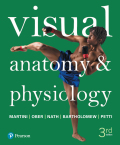
EBK VISUAL ANATOMY & PHYSIOLOGY
3rd Edition
ISBN: 9780134454658
Author: Petti
Publisher: PEARSON CUSTOM PUB.(CONSIGNMENT)
expand_more
expand_more
format_list_bulleted
Concept explainers
Question
Chapter 18.1, Problem 1I
Summary Introduction
To compare: The volume of blood that flows to each circuit from the ventricular systole.
Introduction: The heart is a muscular organ. It pumps the blood all over the body through the circulatory system. It pumps deoxygenated blood to the lungs and oxygenated blood to the rest of the body. Thus, the human heart is called a dual pump. The heart and the blood vessels together constitute the cardiovascular system. The study of the heart is called cardiology.
Expert Solution & Answer
Want to see the full answer?
Check out a sample textbook solution
Students have asked these similar questions
State the location and function of Cardiac center.
(a) Describe how heart contraction and relaxation influence coronary blood flow. (b) Name the major branches of the coronary arteries, and note the heart regions served by each.
State how blood vessel diameter may change as the body adjusts to changes in blood pressure.
Chapter 18 Solutions
EBK VISUAL ANATOMY & PHYSIOLOGY
Ch. 18.1 - Prob. 1RCh. 18.1 - Prob. 2RCh. 18.1 - Prob. 3RCh. 18.1 - Prob. 4RCh. 18.1 - Prob. 5RCh. 18.1 - Prob. 6RCh. 18.1 - The anterior view of the heart is dominated by...Ch. 18.1 - Prob. 8RCh. 18.1 - Name and describe the shallow depressions and...Ch. 18.1 - Prob. 10R
Ch. 18.1 - Prob. 11RCh. 18.1 - Prob. 12RCh. 18.1 - Prob. 13RCh. 18.1 - Prob. 14RCh. 18.1 - Prob. 15RCh. 18.1 - Prob. 16RCh. 18.1 - Prob. 17RCh. 18.1 - Prob. 18RCh. 18.1 - Prob. 19RCh. 18.1 - Prob. 20RCh. 18.1 - Prob. 1LOCh. 18.1 - Prob. 2LOCh. 18.1 - Describe the structure of the pericardium and...Ch. 18.1 - Prob. 4LOCh. 18.1 - Describe the major vessels supplying the heart,...Ch. 18.1 - Prob. 6LOCh. 18.1 - Prob. 7LOCh. 18.1 - Prob. 8LOCh. 18.1 - Prob. 1ICh. 18.1 - Prob. 2ICh. 18.1 - C. Why is it important that cardiac tissue contain...Ch. 18.1 - Prob. 4ICh. 18.1 - Labeing: Label each of the structures in this...Ch. 18.1 - Prob. 2SRCh. 18.1 - Prob. 3SRCh. 18.1 - Prob. 4SRCh. 18.1 - Prob. 5SRCh. 18.1 - Prob. 6SRCh. 18.1 - Prob. 7SRCh. 18.1 - Prob. 8SRCh. 18.1 - Prob. 9SRCh. 18.1 - Prob. 10SRCh. 18.1 - Prob. 11SRCh. 18.1 - Prob. 12SRCh. 18.1 - Prob. 13SRCh. 18.1 - Prob. 14SRCh. 18.1 - Prob. 15SRCh. 18.1 - Prob. 16SRCh. 18.1 - Prob. 17SRCh. 18.1 - Prob. 18SRCh. 18.1 - Prob. 19SRCh. 18.1 - Prob. 20SRCh. 18.1 - Prob. 21SRCh. 18.1 - Prob. 22SRCh. 18.1 - Prob. 23SRCh. 18.1 - Prob. 24SRCh. 18.1 - Prob. 25SRCh. 18.1 - Prob. 26SRCh. 18.1 - Prob. 27SRCh. 18.1 - Prob. 28SRCh. 18.1 - Prob. 29SRCh. 18.1 - Prob. 30SRCh. 18.1 - Prob. 31SRCh. 18.1 - Prob. 32SRCh. 18.1 - Matching: Match each lettered term with the most...Ch. 18.1 - Prob. 34SRCh. 18.1 - Prob. 35SRCh. 18.2 - Prob. 1RCh. 18.2 - Prob. 2RCh. 18.2 - Prob. 3RCh. 18.2 - Prob. 4RCh. 18.2 - Why does tetany not occur in cardiac muscle?
Ch. 18.2 - Prob. 6RCh. 18.2 - Prob. 7RCh. 18.2 - Prob. 8RCh. 18.2 - Prob. 9RCh. 18.2 - Prob. 10RCh. 18.2 - Prob. 11RCh. 18.2 - Prob. 12RCh. 18.2 - Prob. 13RCh. 18.2 - Prob. 14RCh. 18.2 - Prob. 15RCh. 18.2 - Prob. 16RCh. 18.2 - Prob. 1LOCh. 18.2 - Prob. 2LOCh. 18.2 - Prob. 3LOCh. 18.2 - Prob. 4LOCh. 18.2 - Prob. 5LOCh. 18.2 - Describe the factors affecting the heart rate.
Ch. 18.2 - Prob. 7LOCh. 18.2 - Prob. 8LOCh. 18.2 - Prob. 1ICh. 18.2 - Prob. 2ICh. 18.2 - Prob. 3ICh. 18.2 - Prob. 4ICh. 18.2 - Prob. 5ICh. 18.2 - Prob. 1SRCh. 18.2 - Prob. 2SRCh. 18.2 - Prob. 3SRCh. 18.2 - Prob. 4SRCh. 18.2 - P wave
cardiac output
autorhythmicity
“lubb”...Ch. 18.2 - Prob. 6SRCh. 18.2 - Prob. 7SRCh. 18.2 - Prob. 8SRCh. 18.2 - Prob. 9SRCh. 18.2 - Prob. 10SRCh. 18.2 - Prob. 11SRCh. 18.2 - Prob. 12SRCh. 18.2 - Prob. 13SRCh. 18.2 - Prob. 14SRCh. 18.2 - Prob. 15SRCh. 18.2 - Prob. 16SRCh. 18.2 - Prob. 17SRCh. 18 - Prob. 1CRQCh. 18 - Prob. 2CRQCh. 18 - Prob. 3CRQCh. 18 - Prob. 4CRQCh. 18 - Prob. 5CRQCh. 18 - Prob. 6CRQCh. 18 - Prob. 7CRQCh. 18 - Prob. 8CRQCh. 18 - Prob. 9CRQCh. 18 - Prob. 10CRQCh. 18 - Prob. 11CRQCh. 18 - Prob. 12CRQCh. 18 - Prob. 13CRQCh. 18 - Prob. 14CRQCh. 18 - Prob. 15CRQCh. 18 - Prob. 16CRQCh. 18 - Prob. 17CRQCh. 18 - Prob. 18CRQCh. 18 - Prob. 19CRQCh. 18 - Prob. 20CRQCh. 18 - Prob. 1CICh. 18 - Prob. 2CICh. 18 - Prob. 3CI
Knowledge Booster
Learn more about
Need a deep-dive on the concept behind this application? Look no further. Learn more about this topic, biology and related others by exploring similar questions and additional content below.Similar questions
- Describe the location and blood flow through thecoronary arteries and cardiac veinsarrow_forwardBriefly state the organs or parts of organs that are supplied with blood by (a) the cerebral arterial circle, (b) theceliac trunk, (c) the superior mesenteric artery, and (d) theinternal iliac artery.arrow_forward
arrow_back_ios
arrow_forward_ios
Recommended textbooks for you
 Human Physiology: From Cells to Systems (MindTap ...BiologyISBN:9781285866932Author:Lauralee SherwoodPublisher:Cengage Learning
Human Physiology: From Cells to Systems (MindTap ...BiologyISBN:9781285866932Author:Lauralee SherwoodPublisher:Cengage Learning

Human Physiology: From Cells to Systems (MindTap ...
Biology
ISBN:9781285866932
Author:Lauralee Sherwood
Publisher:Cengage Learning